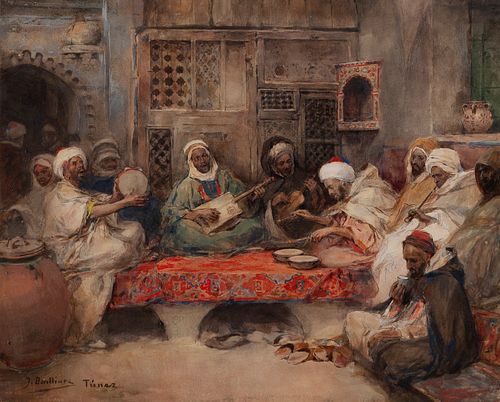JOSÉ BENLLIURE GIL (Valencia, 1855 - 1937). "Inside a cafeteria", Tunisia.
Lot 121
About Seller
Setdart Auction House
Carrer Aragó 346
Barcelona
Spain
Setdart Subastas was born in 2004 and is currently the first online art auction in Spain with solidity, prestige and reliability guaranteed by our more than 60,000 users. Setdart has a young, dynamic and enterprising team ready to successfully manage the purchase and sale of art works through custom...Read more
Estimate:
EUR€15,000 - EUR€20,000
$15,625 - $20,833.33
Absentee vs Live bid
Two ways to bid:
- Leave a max absentee bid and the platform will bid on your behalf up to your maximum bid during the live auction.
- Bid live during the auction and your bids will be submitted real-time to the auctioneer.
Bid Increments
| Price | Bid Increment |
|---|---|
| EUR€0 | EUR€10 |
| EUR€200 | EUR€25 |
| EUR€500 | EUR€50 |
| EUR€1,000 | EUR€100 |
| EUR€3,000 | EUR€200 |
| EUR€5,000 | EUR€500 |
| EUR€10,000 | EUR€1,000 |
| EUR€20,000 | EUR€2,000 |
| EUR€50,000 | EUR€5,000 |
About Auction
By Setdart Auction House
Nov 10, 2021
Set Reminder
2021-11-10 08:00:00
2021-11-10 08:00:00
America/New_York
Bidsquare
Bidsquare : 19th & 20th Century paintings and Decorative Arts
https://www.bidsquare.com/auctions/setdart-auction-house/19th-20th-century-paintings-and-decorative-arts-7800
Setdart Auction House sofia@setdart.com
Setdart Auction House sofia@setdart.com
- Lot Description
JOSÉ BENLLIURE GIL (Valencia, 1855 - 1937). "Inside a cafeteria", Tunisia. Watercolor on paper. Signed and titled in the lower left corner. Preparatory drawing for the work ""Inside a Coffee House, Tunis"" which was sold at the auction ""Important Works from the Najd Collection"", held at Sotheby's London in 2019, whose hammer price reached 646,000 €. Measurements: 36 x 44 cm; 66 x 74.5 cm (frame). Orientalist painters embarked in search of new motifs and experiences to North Africa, the Middle East and Turkey, motivated on the one hand by a genuine fascination and on the other hand by the great demand for the ""exotic"" in Europe. Spanish Orientalists such as Antonio Fabres y Costa and José Benlliure gravitated around the Spanish Academy in Rome, where, inspired by Mariano Fortuny, they produced some of their most important works. The scene is inspired by Benlliure's experience during his travels in North Africa, particularly Tunisia, Morocco and Algeria. However, it appears that the composition is derived from a photograph published in 1892 in La Ilustración Española y Americana, in which he portrays a mise-en-scène of Spanish artists dressed in oriental costumes during carnival celebrations at the Circolo Artistico Internazionale in Rome. Luminous and characterized by loose brushstrokes, the watercolor transports the viewer to the hustle and bustle of a musical evening in a Tunisian café and offers a perspective of daily life in North Africa through the eyes of a Spaniard. The artist's skill in depicting the details of the clothing, as well as the brilliance of the palette, stand out. José Benlliure cultivated costumbrista themes and portraits. He began his artistic studies with Francisco Domingo in Valencia, to later continue his training in Madrid, where he settled in 1869. From an early age he enjoyed the patronage of the King of Savoy and in 1879 he moved to Rome, where he was discovered by the important art dealer Martin Colnaghi, who financed his studies in the city. In 1897 he made several trips to Tangier, Algeria and Morocco where he approached through a realistic, luminous, loose and stained painting to the daily world of the places visited. From 1900 onwards, his work depicts popular themes. He attended the National Exhibitions of Fine Arts, obtaining third medals in the editions of 1876 and 1878 and first in 1887. He belonged to the Academies of San Fernando (Madrid), San Lucas (Rome), San Carlos (Valencia), Brera (Milan) and Munich. Between 1904 and 1912 he directed the Spanish Academy in Rome. The most important part of his production is preserved in Valencia, in his House Museum and in the Museum of Fine Arts San Pío V. He is also represented in the Prado Museum, the Thyssen-Bornemisza and the Palace of Charles V in Granada, among others."
- Shipping Info
-
In-house shipping available. Please inquire at admin@setdart.com.
-
- Buyer's Premium



 EUR
EUR CAD
CAD AUD
AUD GBP
GBP MXN
MXN HKD
HKD CNY
CNY MYR
MYR SEK
SEK SGD
SGD CHF
CHF THB
THB








